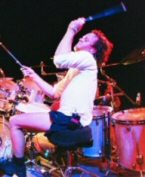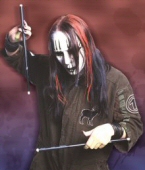|
¤¤¤¤¤¤¤¤¤¤¤¤¤¤¤¤¤¤¤¤¤¤¤¤
STARTSIDEN
PRISER OG BESTILLINGER
AHEAD - BIG BANG PRODUKTER
AHEAD
ARTISTER
AGNER - TWINSTICK TROMMESTIKKER, ARTISTER, etc.
DIVERSE PRODUKTER NYHETER
| |
Til startsiden
NYHETER, etc.
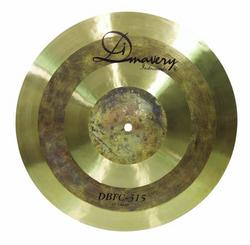 |
DBFC-315 Cymbal 15" Crash
Semi-profi 15"
Crash-Cymbal
Pris 880,-
! Flere modeller i prislisten |
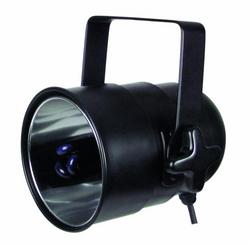
UV-spot
incl. UV energy saving lamp 25W
Complete UV-spot
-
High
quality reflector
-
UV-lamp included
|
|
AHEAD EXPANDING LINES NEW BRUSHES & RODS
New for 2008 Ahead Drumsticks is expanding their new and innovative products
to include a superior line of brushes and bundled sticks built to outplay
and outlast.
The line consist of two Bundled Bamboo rods heavy and light, two rock rods
heavy and light, and bundled stick with accent tip.
The models feature Ahead’s handles as well as the VRS system to reduce shock
to the joints and hands.
|
|
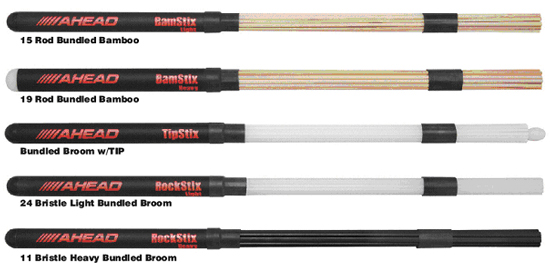 |


AHEAD Speed Metal
|
Best Snare
Ahead Snare
Not so much of a shock here, it was destined to become the
snare that everyone wanted after a few pics made their way back from NAMM
back at the beginning of last year. This is the drum everyone is talking
about - and rightly so. Great drums, great construction, great sound. Now
with an extended range, you need to go and check these bad boys out
.
|
Best New Product
Ahead Snares
Formatively known as a stick company only, Ahead seems to
have pulled a trump card out of the air with their new metal snares. It was
voted NAMM product of the show by guys on this very site and you can also
ready a full review is in the site archives
here. Have a read through. I think you’ll be as impressed as we were…
Se mer, klikk
here.
|
|
Ahead Snare
Drum
Brass Shell, (smoked Chrome)
with tube lugs
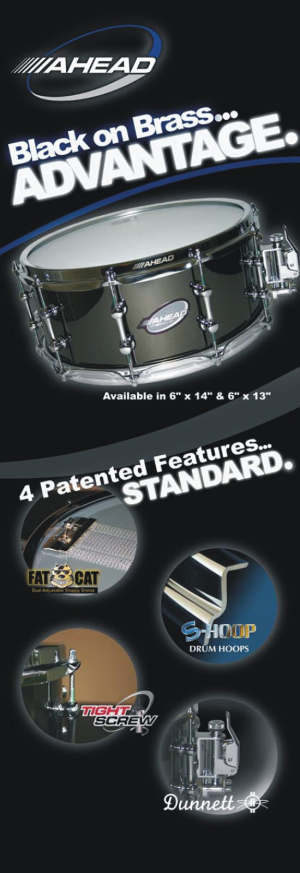
Available
in 2 sizes 6x14" and 6x13"
|
Ahead Skarptromme
Fra Musikkpraksis 1-07:
Ahead
Ahead var og er de største på trommestikker
av kunstmateriale. Det er fortsatt de hardtslående trommeslagerne som
benytter dette merket. Tommy Lee, Joey og Lars Ulrich.
Det er allikevel deres skarptromme jeg må
nevne fra årets NAMM Show, en fenomenal klar og tydelig skarp som vil bære
gjennom de fleste lydbilder.
Omtalen i media har vært storslagen, og
oppmerksomheten på messen tyder på suksess.
Simon
Edgoose
Mikedolbear.com
Famed for their aluminium sticks, Ahead have ventured into a new area. On
the Ahead stand were some new metal snares. Now, I must admit to not being
tremendously excited by the prospect of another new snare drum, but at the
risk of sounding like an advert… “That was before I heard it!”. The shells
are very thin and are 14” or 13” x 6” in black chrome over brass. They have
tube lugs, Fat Cat snares (with the adjustable tension inner wires), S-Hoops
(triple flange hoops with a larger top flange angled over the bearing edge,
which sound more like cast hoops), Tight Screw tension rods (which have an
insert of nylon to guarantee they never de-tune) and a choice of Dunnett or
Trick throw offs. Now, on paper, they should sound good, but I think that
Gerry and I decided they were they best snare we had heard so far at NAMM.
When the person who was showing us them first hit one, a guy who was passing
stopped and came over and asked what the snare was as it sounded
‘incredible!’. It is stupidly loud (making us blink in a hall with 20m high
ceilings) but also REALLY musical.
One to check out.
Representant i Norge:
SKANDINAVISK BUREAU A/S
|
|

Ahead Snare Drum
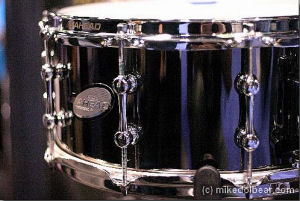 |
‘Greater than the sum of its parts’ is an expression
that we have all probably used at some time or other but
probably not much about drums. After all, when have you
ever heard anyone say ‘ yes, but if Ludwig’s nut boxes
were as good as their shells, they would still be a major
player’ or ‘with those bearing edges and that wrap, Leedy
made the best snares in the ‘60’s’. No, we take drums,
usually, for what they are, a whole unit, and not
individual pieces. Ok, so advances are made in different
areas, bearing edges, rims, nut boxes etc, but its only
the custom boutique builders who really allow you to put
Yamaha rims, Tama nut boxes and custom lapped Okapi skin
twin-ply heads onto a 49 alternating maple, birch and
balsa ply shell with 56 degree bearing edges. It’s not
often you get a manufacturer who openly says, ‘we got the
shell from here, the lugs from them, the rims from over
there and the snares from this company’ (although many do)
but that is what in effect is loudly and proudly happening
here. Enter the Ahead snare drums.
Ahead launched their metal shell snares at this
years NAMM show where they immediately got bloggers going
on about the sound and the features. It’s unusual for a
drumstick company to go directly into drum production, but
I can see why they have done it, and it’s probably a very
clever idea.
The drums them selves are black chromed brass shells
in 14 and 13” x 6” sizes. What makes them different is the
‘extras’ on the shell. The rims are S-Hoops, the snare
wires are Fat-Cat ones, the tension rods are Tight Screw
and the strainer is either the Dunnet R or the Trick 007.
I’ll look at each of these extras but first lets look at
the ‘standard’ pieces on the review model which is the
13x6”.
The shell is a standard looking brass model that is
bent and welded (i.e. not a spun shell) and the seam is
perfect on the outside and visible but smooth on the
inside. The black chrome finish is deep and glossy and as
the shell has no bead, there is a nice open expanse of
shiny blackness, which looks great. The bearing edges are
45 degree and rounded and very smooth, and (drum sniffers
beware) the shell smells great on the inside (sorry, but
had to get that in there). |
|
The lugs are standard issue tube lugs of the World
Max design (I don’t know if they are or not, but that’s
what they look like) which have a tapered tube between two
rounded vaguely Gladstone type pillars. The lugs are
bolted onto the shell through some vinyl bushings, using
screw cups and standard lug bolts and while they aren’t as
sexy as traditional tube lugs, they work perfectly well.
On the shell are Ahead badged Remo heads – Ambassadors –
with a coated on top and clear snare on the bottom. The
air hole is the usual tapped and bolted kind and the Ahead
badge, which is metal, is bolted to the shell too and has
the serial number stamped in it. That’s it for the
standard equipment… lets look at the extras.
The S Hoops look almost like traditional triple
flange ones, but their USP is their large top flange. On a
traditional triple flange, the top edge is bent out wards
(or occasionally inwards) and is 2 or 3mm wide. It’s
common knowledge that the more bends in a piece of metal,
the more rigid it is, and the larger the bend, the greater
the effect. What S Hoop have done is bend the top edge
towards the centre of the snare and make it about a
centimetre wide. It is angled down so that it doesn’t
interfere with rim shots unless you pull the stick so far
back that the stick tip only hits about 3cm from the edge.
This top flange makes the hoops very rigid – it feels nice
and solid when off the drum. The rim is made from 2.3mm
steel and when suspended on a finger, rings like a bell –
always a good sign (no dodgy welding). The hoop feels
quite weighty and there is an Ahead decal on one side.
Being the 13” model, there are 8 lugholes.
|
|
The S Hoop is tightened onto the shell with Tight
Screw tension rods. These are traditional rods except they
have a channel machined down the thread and a nylon insert
has been put in it. This has the effect of stopping the
tension rods moving. It’s a very simple and effective idea
and obviously can be used as a retrofit on any drum that
doesn’t have nylon inserts in its lug nuts. They also have
captive washers that are to be praised – no more
scrabbling about on the floor looking for lost ones.
The snare release on the review model is the Trick
007 model. Now, I have nothing against the throw off, but
I was rather hoping for the Dunnett model. The Trick works
fantastically well, but… well, I don’t know, aesthetically,
I’m not sure. It could be because it resembles a Dalek,
but it doesn’t do it for me. The Dunnett model works
brilliantly too, and with it’s 180 degree (well, slightly
more) movement, it just has the edge. The butt end is the
normal Piston Works/Trick variety and both strainer and
butt are secured using Allen key bolts. |
| Lastly, the Fat Cat snares - these were the aspect
of the drum I was most intrigued about. The ones on the
drum are 24 strand, but they are divided up into a group
of 6 on either side and a group of 12 in the middle. What
makes them unique is that, using a screwdriver, you can
loosen the tension of the middle 12 strands so making them
have two different tensions at the same time. The purpose
of this is that you can have the outer sets tight enough
to respond well at low dynamics (where the looser inner
set will sound rattley and without definition) and the
inner, looser, set to respond better at louder dynamics (when
the tighter inner sets will sound choked). In theory it
really is a snare wire for all seasons. How does it work?
It’s a very simple principal – all the wires are connected
to the same snare plate at one end, but the middle 12
wires are slightly shorter than the outer ones. The inner
ones are connected to a narrow plate that has a 90-degree
bend in it. A screw passes through the bent up piece of
the plate and screws into a corresponding 90-degree bent
up piece of plate on the snare plate that the other,
longer, wires are connected to. When fully tightened, the
wires are all the same tension, but by loosening the screw,
the inner 12 wires are loosened too, hence the different
tensions. It sounds complicated, but it’s not… promise!
|
|
So lets put the drum back together and see how it
works.
First thing I noticed was that due to the very
nature of the Tight Screws, it takes longer to put heads
on as you cant spin the key to take up the slack. That’s
not really a problem, as they don’t move at all once they
are tensioned, but it is something to bear in mind and you
cant tune by ‘feel’. Another thing I noticed was that the
more I removed and inserted the Tight Screws, the more
worn the nylon got and the more easy it got to turn the
screws. In other words, the more you use them, the more
they became susceptible to detuning from vibration, which
defeats the point of them. Hmmm…
In order to test the rigidity of the hoops, I turned
the snares off, tuned the drum to an even pitch and then
loosened one of the tension rods completely until I could
remove it. On a drum with a traditional triple flange hoop,
the pitch of the drum would have dramatically dropped by
the lug I had loosened, where as the other lugs would have
remained closer to their original pitch, apart from the
ones either side of the loosened one. This is because
triple flange hoops bend easily. On the other hand, a
diecast hoop (which are generally quite expensive),
doesn’t flex as much as it is a solid casting of zinc or
aluminium. I would expect, in the same situation, the
pitch of the whole head to drop slightly, but for the
pitch around the head to be fairly consistent. This would
be because there would be less tension on the head but the
rims rigidity would keep the tension consistent. I was
curious to see what the S Hoop would do…
|
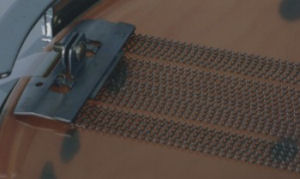 |
|
The Fat Cat snare wires on a
non Ahead snare |
After playing about with the tension, the S Hoop
behaved the same as a die cast hoop would have done, but
to a greater degree. The pitch dropped dramatically, like
the triple flange, but was much more consistent around the
head like the die cast. This goes to show that the S Hoop
behaves like a diecast hoop by being rigid, but has the
sound of the thinner triple flange hoop - it seems to be a
happy medium between the two.
The Fat Cat snares were next up for a close perusal
and I immediately spotted a problem. The 90 degree bent
section of the snare wire plates came lower than the
bottom edge of the snare side rim. This means that when
you put the drum on the floor or in a case with a flat
bottom, all the weight of the drum is pushing onto the
snare head. This could be a problem. The bottom snare hoop
needs to have a snare gate/guard so the weight is put onto
the hoop rather than the fragile head. This could be
tricky due to the design of the hoop, but Ahead could
easily attach a bent wire guard to the shell of the drum
which would get around all the problems and could sit
proud of the lower edge of the S Hoop. If you buy one of
these drums, DO NOT REST IT ON THE FLOOR, until the
problem is sorted, unless you want to buy loads of snare
heads and snare wires.
Practically speaking, the dual tension snare worked
well. However, I am probably not the best person to try
these as I have my snare wires looser than most people as
I find they record and mike better and give you a bigger
sound. BUT, I should say that whether I used the dual
tension function or not, the actual wires sounded great –
crisp and sensitive, but not quite in the same league as
Canopus or Puresound.
The Trick throwoff worked great. The one on the
review model was a little stiff so small loosenings in
tension did not immediately transfer to the snare wires –
I found I had to release the snares and then put them on
again for the changes to take effect. Tightening the
snares worked immediately however. Other Trick throwoff
haven’t done this, so I am putting it down to this
particular one being under lubricated. It’s not the
quietest of releases but it works well. The physical
motion of applying and releasing the snares by moving your
hand around the drum does distinguish it from most other
releases where you move your hand parallel to the top rim
of the drum or away from the shell. |
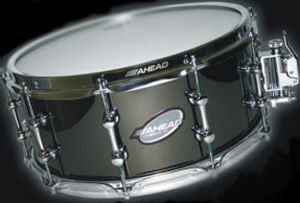 |
|
The snare with the Dunnett
throw off - the other option |
Now, after all this, you are probably thinking that
I didn’t like this drum. Well, I took it on a function gig
where I would be playing everything from brushes to out
and out slamming backbeats, and also I took it down to the
studio and listened to it under mics. And?
Wow! This is one hell of a drum. Forget all the
extras, this drum sings. It’s great for brushes and it
sounded crisp and brush rimshots sounded really nice and
full. With sticks, the cross stick was a little weak (but
I am used to wooden hoops), but ghost notes and rim shots
were wonderful. I haven’t had this much fun with a snare
in ages. The tuning held perfectly and the drum has a real
quality ‘crack’ to it. I had heard it was loud, and it
certainly is, though I think maybe it just produces very
cutting ‘nice’ frequencies rather than more volume as such.
The needles (oh, ok, LED meters) in the studio weren’t
going any higher, but it certainly sounded loud.
The drum never seemed to choke and took it’s beating
quite happily. Ghost notes were a pleasure, and to be
honest, on the gig, I never felt the need to play with the
snare tensions as it coped with everything I threw at it.
I messed with the snare tensions in the studio, and they
did make a subtle difference, but not one that the
audience will notice, but certainly from behind the kit,
it was rather pleasant. I tend to use mostly wood shell
snares, with the exception of one aluminium 14x5”, but
this reminded me how good brass shells can be. The reduced
diameter and the greater depth (going from a 14x5” as a
yard stick) really work well. I use a 13x7” beech shell a
lot for recording, which also has the same crisp fatness,
but I think I will have to invest in a few brass shells.
I’ve got to say it, but this drum is greater than
the sum of its parts. To be honest, I am not sure if it’s
any better for having the Fat Cat snares or the Tight
Screw rods, but the shell, rim and head combination works
really well. If you were to go into a drum shop and try
one, I challenge you not to like it. Whether or not you
like it enough to buy one is a different matter, but it
really is good. It’s not perfect, but you may overlook any
shortcomings when you hear it.
Go on… just one hit… |
Representant i Norge:
Skandinavisk Bureau A/S |
Travis Smith
There's no such thing as a
band born to greatness. To succeed in the world of music there's a whole
energy-sapping storm of hard work to plough through. Florida's Trivium
has surely earned the major contender status that has been afforded them
by the international media. After spending the last few years up to
their necks in blood, sweat and tears, the formidable foursome, whose
2005 sophomore release (and Roadrunner debut) Ascendancy made them a hit
with discerning music fans everywhere, have paid their dues. Relentless
touring around the world with over 350 shows in the past two years has
sharpened the band's live prowess, making their new album, The Crusade,
one of the most hotly anticipated hard rock albums of 2006. The level of
charisma and energy that they've harnessed since hitting the global gig
circuit has built Matthew K. Heafy, Corey Beaulieu, Paolo Gregoletto and
Travis Smith a huge international fan base that is as devoted as it is
ever growing.
|
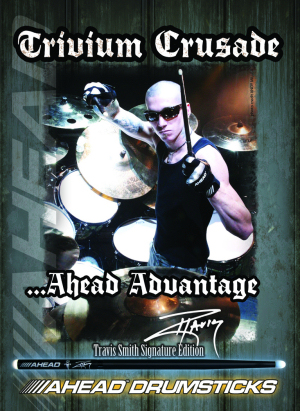
|
|

Three
reasons Travis says he uses AHEAD products:
- Durability, long
lasting sticks that don't "burn out" after only a few songs.
- Shock Absorbing,
playing 250 plus shows a year can be a bitch on a drummers wrists
night after night. With AHEAD sticks my wrists rarely get achy.
- Rebound, the rebound I
get from AHEAD sticks is amazing and what's really important is I
don't spend too much time thinking about my hands, which gives me more
time to think about my feet!
Ahead
Gloves combined with Ahead stick grip give me comfort knowing my hands
wont get completely shredded up and that I will have less of a chance to
drop a stick. They give me the reliability and durability I expect.
|
|
|
AHEAD DRUMSTICKS HYBRID SERIES
Ahead Drumsticks is proud to announce it latest NEW drumstick
models to its arsenal. The NEW 5AB Hybrid Series. They are a
blend of two sizes with balance and consistence most drummers
have become a custom to with Ahead. The blend of the 5B handle
into a 5A taper has given the new 5AB’s the balance and versatily
many drummers have been asking for. There are two models available:
5ABS – STUDIO HYBRID 16” length
5ABC
– CONCERT HYBRID 16,25” length
 |
|
FIREFLY
DYNAMIC TUNING DEVICE
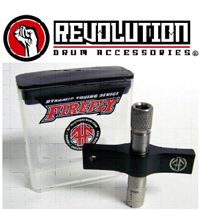
|
Revolution Drum
The FIRE FLY
dynamic tuning device is perhaps the most innovative and efficient
drum key ever made. Its primary feature is the use of a cam clutch
bearing. This type of bearing allows the user precise ratcheting
minus the annoying clicks and play of a standard ratcheting key. Its
features a ergonomic handle for users comfort and is equipped with
knurled ends for lighting fast head changes. The FIRE FLY is cnc
machined for long life and durability.
The FIRE
FLY drum key is a must have for every drummer and drum tech.
Raymond Herrera (Fear Factory)
|
|
|
|
NEW! GPI Stick Pods
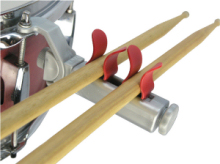
|
Tilbake til Startsiden
|
